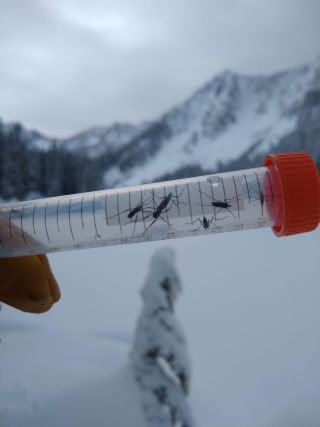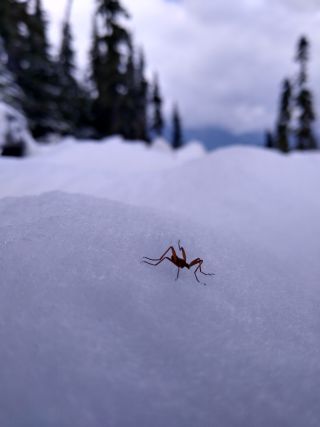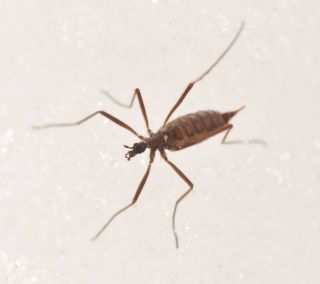Animal Behavior
Snow Flies Have a Trick to Survive Freezing Temperatures
These insects practice self-amputation to prevent encroaching ice formation.
Updated October 17, 2023 Reviewed by Devon Frye
Key points
- Snow flies are one of the only insects that remain active in snowy environments.
- Researchers used thermal imaging to document snow flies walking at temperatures as low as −10°C.
- Snow flies detect internal ice formation and self-amputate freezing legs, preventing ice spread to the body.

Snow flies seem to defy logic. These wingless flies are commonly seen scurrying across snow-covered surfaces at temperatures that would paralyze and kill most other insects.
Now, researchers have discovered one startling strategy that helps snow flies survive sub-zero conditions: self-amputation. When a snow fly detects ice forming in one of its limbs, it rapidly detaches it to prevent ice crystals from spreading into its body.
Unexpected Insects
John Tuthill, a neuroscientist at the University of Washington, studies flies for a living. His lab uses the fruit fly as a model organism to understand how the brain controls behavior. But happening upon snow flies while out in the frigid mountains around Seattle took him by surprise.
“It boggled my mind that these animals were able to be out there, living and moving under those conditions,” he says.

The encounter inspired him to start a side project studying snow fly behavior in the lab. Although about 40 species of snow fly live across the northern hemisphere, the insects are not well understood. That may be because they can’t be bred in the lab and are challenging to collect from the wild. Their larval stage is largely a mystery; they are only seen by people as adults, running around on snowy surfaces while searching for mates.
The conditions where you find snow flies are also the ideal conditions for backcountry skiing, says Tuthill. To supplement the flies he collects himself, Tuthill has created a crowd-sourced science project asking skiers and mountaineers to collect snow flies and send them to his lab. Between his own collecting trips and the flies sent in from citizen scientists, Tuthill amassed enough snow flies to investigate how they survive in their icy home.
Freezing Flies
Tuthill and colleagues used a thermal camera to record snow flies as they walked on increasingly cold plates. The insects continued to move about even as the temperature dipped below 0°C.
For comparison, the team tried the same experiments with crane flies, cousins of snow flies that are active in the summer months. At the same sub-zero temperatures at which snow flies seemed unbothered, crane flies entered a coma-like state of minimal and uncoordinated movement.
Further experiments showed that snow flies aren’t immune to freezing—sustained, extremely low temperatures would eventually lead to the formation of ice within their bodies, which was fatal.
But the bugs had a trick to avoid this fate. Sometimes, a limb in contact with the cold plate began to freeze. When this happened, the snow fly rapidly self-amputated the leg before ice crystallization could spread to its vital organs.
Tuthill says self-amputation was preceded by a sudden spike in body temperature, the result of liquid water releasing heat as it crystallizes into ice. “Snow flies seem to actively detect that a leg is frozen and then contract a specialized muscle in the leg that triggers amputation, preventing the ice from reaching their bodies,” he says. (Watch a thermal recording of a self-amputation.)
Sacrificial Limbs
Overall, the team found snow flies that amputated frozen legs survived longer and to lower cold plate temperatures. In the wild, this ability may allow them enough time to find a cozy burrow beneath the snow when temperatures drop or weather conditions change.

In hindsight, the finding made a lot of sense to Tuthill and the team. He says that nearly 20 percent of the snow flies they collected were missing one or more legs. The researchers have even observed snow flies with multiple missing limbs effectively navigating snowy terrain in the wild, like this three-legged snow fly.
Snow flies aren’t unique among insects in their propensity to drop a limb. Their close relations the crane flies and some other insects can self-amputate legs in response to pulling, such as when they are captured by a predator. But the snow flies didn’t lose their limbs when Tuthill’s team tugged on them. They only self-amputated in response to freezing.
“This behavior probably evolved from an ancestral crane fly that could self-amputate to escape predators,” says Tuthill. “In snow flies, it’s been repurposed so they can avoid freezing. It’s an unusual adaptation that I don’t think has been shown in any other animal.”
Learning From Nature
Now that he’s probed the limits of the snow fly’s cold tolerance, Tuthill wants to study the neurons and molecules that mediate self-amputation. He’s collaborating with other labs to sequence a snow fly genome to understand how they’ve evolved to thrive in the cold.
This project may do more than just reveal biological curiosities. Insights gained from snow fly biology have the potential to improve technologies for cryogenic preservation of human organs and medicines.

Then there are the applications we haven’t even thought of yet. “There is a long history of studying extremophiles, animals that are adapted to extreme environments, and stumbling into basic biology that turns out to be useful in some unexpected way,” says Tuthill.
For instance, Unilever uses an antifreeze protein to produce low-fat ice cream that remains smooth and creamy. The protein (now manufactured by the company) was originally discovered in the blood of an Arctic fish called an eelpout.
“We have certainly learned a lot from studying model systems such as fruit flies,” says Tuthill. “But by focusing on just a few model organisms, we may overlook the unique biology possessed by the thousands (if not millions) of less studied species and miss out on interesting and diverse adaptations.”
References
Golding D, Rupp KL, Sustar A, Pratt B, and Tuthill JC. Show flies self-amputate freezing limbs to sustain behavior at sub-zero temperatures. Current Biology, September 26, 2023. Doi: 10.1016/j.cub.2023.09.002.




